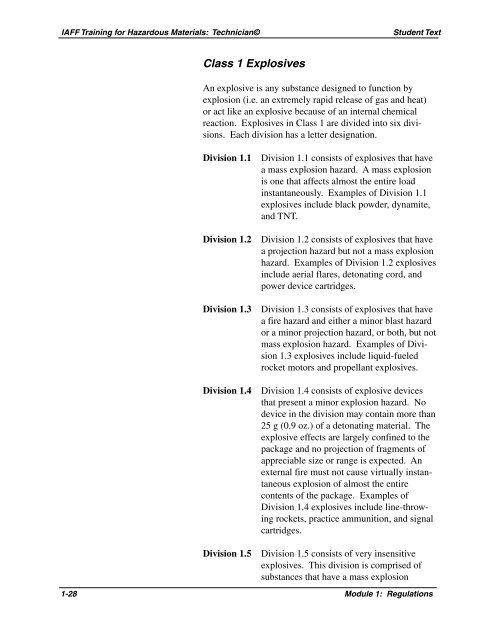Module 1: Regulations - International Association of Fire Fighters
Module 1: Regulations - International Association of Fire Fighters
Module 1: Regulations - International Association of Fire Fighters
Create successful ePaper yourself
Turn your PDF publications into a flip-book with our unique Google optimized e-Paper software.
IAFF Training for Hazardous Materials: Technician© Student Text<br />
Class 1 Explosives<br />
An explosive is any substance designed to function by<br />
explosion (i.e. an extremely rapid release <strong>of</strong> gas and heat)<br />
or act like an explosive because <strong>of</strong> an internal chemical<br />
reaction. Explosives in Class 1 are divided into six divisions.<br />
Each division has a letter designation.<br />
Division 1.1<br />
Division 1.2<br />
Division 1.3<br />
Division 1.4<br />
Division 1.5<br />
Division 1.1 consists <strong>of</strong> explosives that have<br />
a mass explosion hazard. A mass explosion<br />
is one that affects almost the entire load<br />
instantaneously. Examples <strong>of</strong> Division 1.1<br />
explosives include black powder, dynamite,<br />
and TNT.<br />
Division 1.2 consists <strong>of</strong> explosives that have<br />
a projection hazard but not a mass explosion<br />
hazard. Examples <strong>of</strong> Division 1.2 explosives<br />
include aerial flares, detonating cord, and<br />
power device cartridges.<br />
Division 1.3 consists <strong>of</strong> explosives that have<br />
a fire hazard and either a minor blast hazard<br />
or a minor projection hazard, or both, but not<br />
mass explosion hazard. Examples <strong>of</strong> Division<br />
1.3 explosives include liquid-fueled<br />
rocket motors and propellant explosives.<br />
Division 1.4 consists <strong>of</strong> explosive devices<br />
that present a minor explosion hazard. No<br />
device in the division may contain more than<br />
25 g (0.9 oz.) <strong>of</strong> a detonating material. The<br />
explosive effects are largely confined to the<br />
package and no projection <strong>of</strong> fragments <strong>of</strong><br />
appreciable size or range is expected. An<br />
external fire must not cause virtually instantaneous<br />
explosion <strong>of</strong> almost the entire<br />
contents <strong>of</strong> the package. Examples <strong>of</strong><br />
Division 1.4 explosives include line-throwing<br />
rockets, practice ammunition, and signal<br />
cartridges.<br />
Division 1.5 consists <strong>of</strong> very insensitive<br />
explosives. This division is comprised <strong>of</strong><br />
substances that have a mass explosion<br />
1-28 <strong>Module</strong> 1: <strong>Regulations</strong>
















